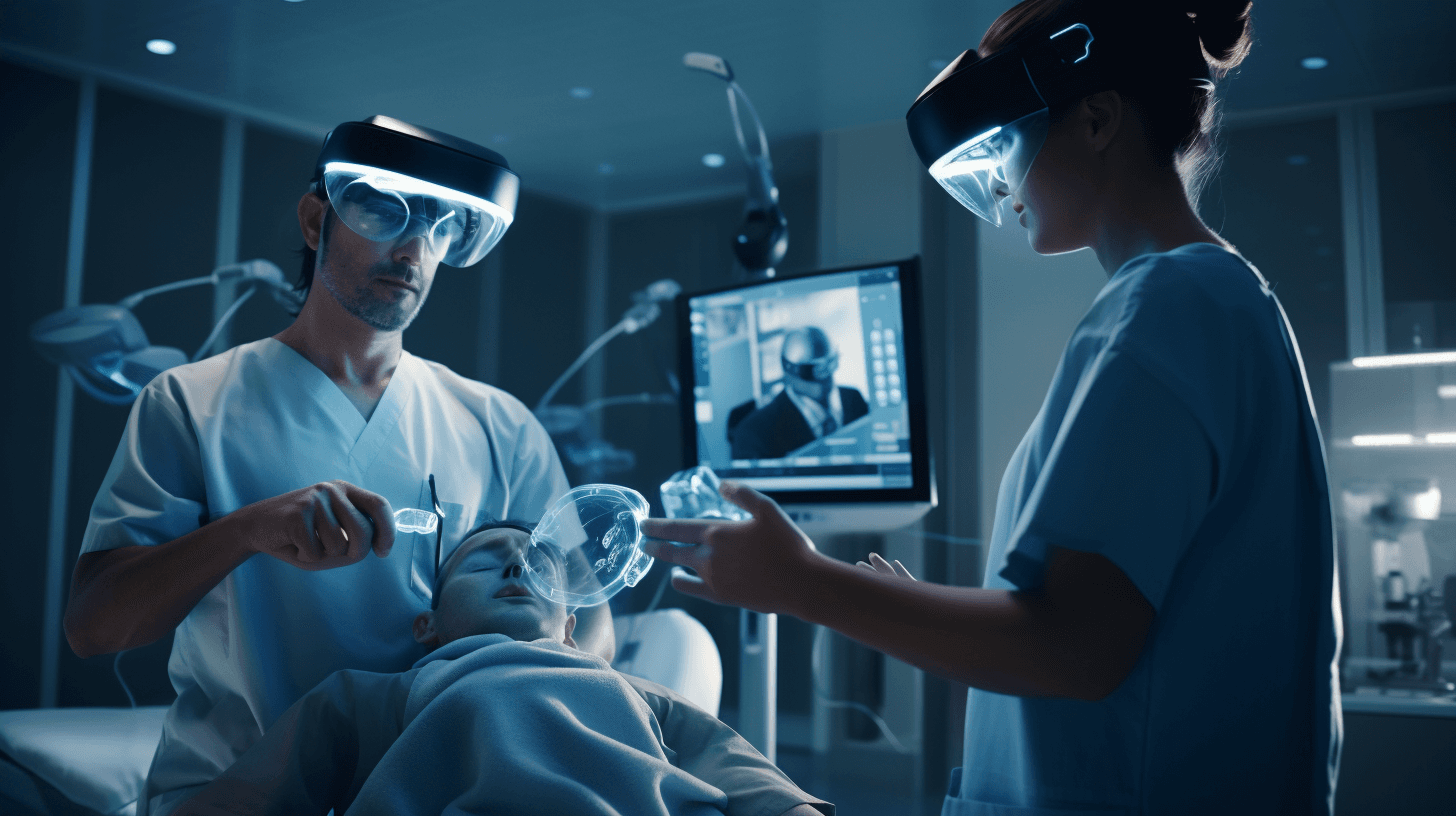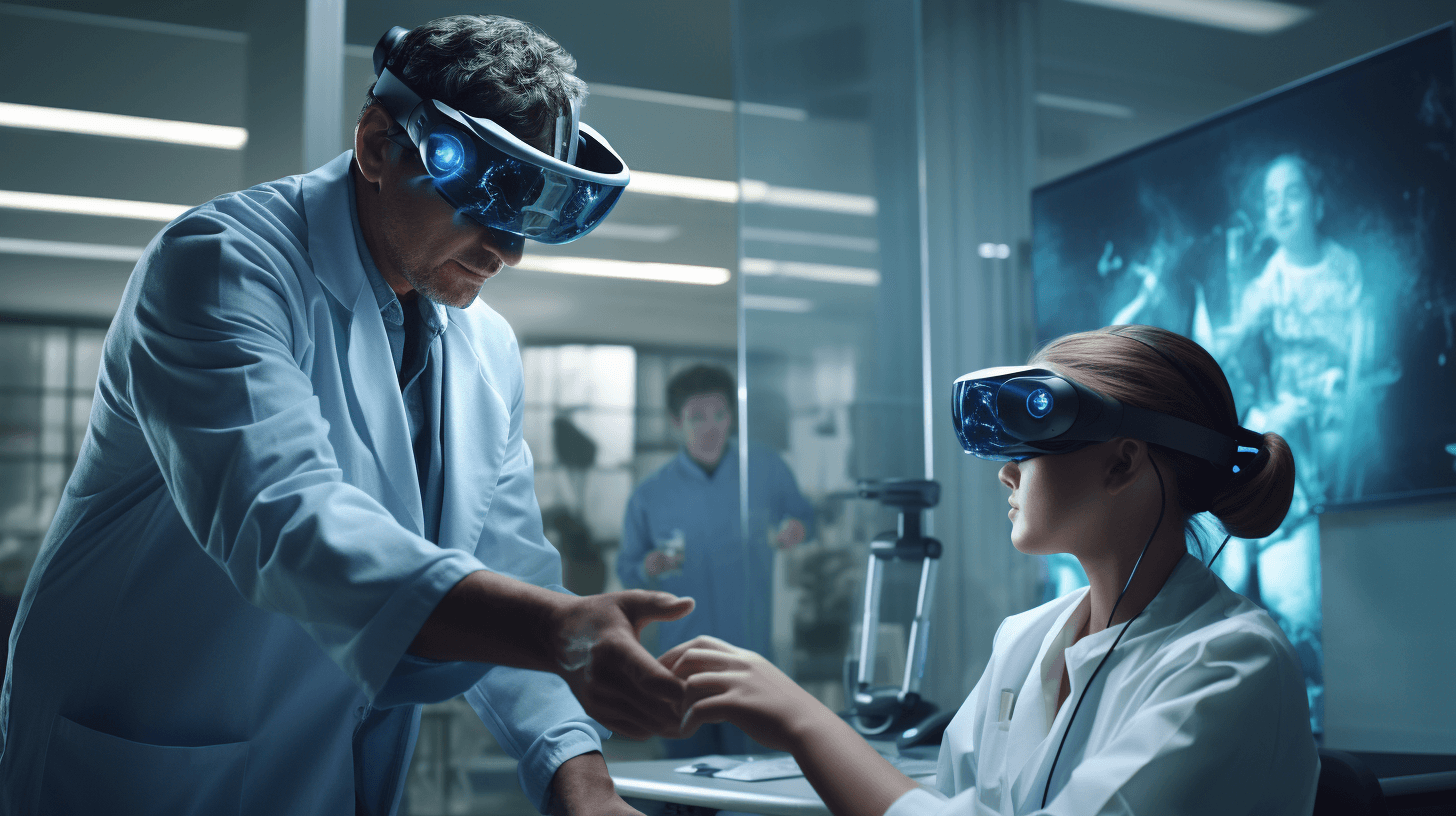Welcome to the fascinating intersection of technology and healthcare, where Augmented Reality (AR) is not just an innovation but a revolution in the making. As we embark on this exploration, we'll dive into a realm where science fiction becomes science fact, bringing profound transformations to the medical field.
Augmented Reality (AR), a technology that overlays digital information onto the physical world, has evolved from a niche concept into a groundbreaking tool across various industries. In healthcare, this evolution marks the beginning of a new era. AR is not just enhancing the way medical professionals interact with data; it's reshaping patient care, medical training, and the overall healthcare experience.
Imagine a surgeon being able to see through layers of tissue during an operation, or a medical student practicing complex procedures in a risk-free virtual environment. These scenarios, once confined to the realms of imagination, are now every day realities thanks to AR. This blog post aims to illuminate the transformative role of AR in healthcare – from providing real-time, life-saving information during surgeries to revolutionizing medical education and patient care.
Join us as we navigate through this groundbreaking journey, where technology meets medicine, and discover how Augmented Reality is not just enhancing healthcare practices but also offering new hopes and possibilities for better health outcomes.
The Distinctive World of AR vs. VR
At its core, Augmented Reality is a technology that overlays digital information onto the real world, augmenting our physical surroundings with computer-generated sensory inputs like sound, video, or graphics. Unlike traditional screen-based media, AR offers an interactive experience that blurs the lines between the physical and digital worlds. This immersive technology uses cameras, sensors, and advanced computing to perceive the environment and then intelligently adds virtual elements to it, enhancing our perception and understanding of the real world.
While AR integrates digital elements into the real world, Virtual Reality (VR) transports users into a completely virtual environment. VR requires headsets that block out the real world, immersing the user in a digital universe. In contrast, AR allows users to stay in touch with reality while interacting with virtual objects, offering a more seamless blend of the digital and physical worlds. This fundamental difference makes AR uniquely suitable for applications where real-world context is crucial, such as in healthcare.
Suggested Read
10 Healthcare Business Ideas For Startups In 2023
View Blog
Enhanced Medical Training and Education through AR
The use of AR in medical and nursing education represents a significant leap forward from traditional teaching methods. In fields where understanding the complexity of the human body is crucial, AR provides an unparalleled interactive learning experience. Students can explore detailed 3D models of human anatomy, seeing how organs function or how diseases affect the body, all in real time and within a real physical space.
Interactive AR Modules: The Future of Medical Training
Interactive AR modules have taken training in complex medical procedures to a new level. Surgeons and medical students can now practice surgeries in a highly realistic, risk-free virtual environment. This hands-on approach through AR simulation allows for a deeper understanding of surgical procedures, reducing errors and improving surgical outcomes.
Real-World Success Stories
There are numerous case studies showcasing the successful implementation of AR in medical education. One notable example is the use of AR technology at Johns Hopkins University, where AR has been employed to guide spinal surgeries. Surgeons use AR headsets to "see through" the patient, allowing them to navigate around critical structures like nerves and blood vessels with unprecedented precision. This not only enhances the training experience for students but also significantly improves patient safety and surgical outcomes.
In another instance, the Cleveland Clinic uses AR for cardiac surgery training. This program allows medical students to interact with a 3D heart, gaining insights into the intricacies of heart surgeries. Such immersive experiences are proving to be invaluable in preparing the next generation of healthcare professionals.
Through these advancements, AR in medical education is not just a technological marvel but a critical tool in shaping a more skilled and prepared healthcare workforce. This blend of innovation and practical application underscores the profound impact AR is having in the realm of medical training and education.
Improved Surgical Precision Through Augmented Reality
The integration of Augmented Reality into surgical procedures has marked a groundbreaking shift in the medical field. This fusion of technology and healthcare is not just enhancing the capabilities of surgeons but is also paving the way for more precise and safer surgeries.
AR in the Operating Room: Real-Time Data and Imaging
At the heart of AR's revolutionary impact in surgery is its ability to provide surgeons with real-time data and imaging, directly within their field of vision. Imagine a surgeon, performing a complex operation, who can see crucial information like the patient's vital signs, 3D models of the patient's anatomy, or even the exact location of a tumor overlaid on the patient's body. This information is displayed through AR glasses or screens, allowing surgeons to keep their focus on the patient without the need to look away for data.
The Breakthrough of AR-Guided Surgeries
AR-guided surgeries represent a significant advancement in medical procedures. By superimposing a digital roadmap onto the patient's body, surgeons can navigate complex anatomical structures with enhanced accuracy. This technology is particularly beneficial in surgeries that require extreme precision, such as neurosurgery or minimally invasive procedures. The benefits are manifold: reduced risk of complications, shorter surgery times, and quicker patient recovery.
Transforming Patient Care and Rehabilitation with Augmented Reality

In the dynamic world of healthcare, Augmented Reality is emerging as a vital tool, not just for surgical precision but also for enhancing patient care and rehabilitation. This cutting-edge technology is opening new avenues in diagnosis, treatment planning, and patient engagement, fundamentally reshaping the patient care journey.
Revolutionizing Diagnosis and Treatment Planning
AR's role in patient diagnosis and treatment planning is akin to giving medical professionals a new set of eyes equipped with deeper insights and data. For instance, AR applications can overlay 3D visualizations of a patient’s internal organs over their body, aiding doctors in understanding the complexities of an individual's condition in real time. This enhanced visualization aids in more accurate diagnoses and more effective treatment plans.
In cancer treatment, for instance, AR can be used to project the precise location and size of tumors onto the body of the patient, allowing oncologists to determine the best approach for treatment. Similarly, in cardiology, AR can be used to visualize heart conditions, enabling cardiologists to assess the severity of a condition more accurately and plan appropriate interventions.
AR in Physical Therapy and Rehabilitation
Physical therapy and rehabilitation are also witnessing a revolution with the introduction of AR. AR applications in these fields bring an interactive and engaging element to the rehabilitation process. Patients can use AR for guided exercises, where they can see and correct their movements in real time. This not only helps ensure the exercises are performed correctly but also adds an element of gamification, which can be highly motivating for patients.
For example, stroke survivors undergoing rehabilitation can use AR applications to practice and regain control of their motor skills. The AR system tracks their movements and provides instant feedback, helping patients improve their coordination and strength more effectively.
Enhancing Patient Understanding and Engagement
One of the most significant advantages of AR in healthcare is its ability to enhance patient understanding and engagement. Through AR visualization, patients can see a more tangible representation of their health conditions. This clarity plays a crucial role in patient education, helping them understand their medical conditions, the impacts of their treatment choices, and the importance of adherence to medical advice.
For instance, AR applications can show patients how a particular surgery will be performed or how a medication will affect their bodies. This immersive form of education not only demystifies medical procedures but also empowers patients to take an active role in their healthcare journey.
The integration of AR in patient care and rehabilitation is not just a technological advancement but a paradigm shift in the healthcare sector. By enhancing diagnostics, revolutionizing physical therapy, and improving patient engagement, AR is playing a pivotal role in delivering more effective, efficient, and personalized healthcare services. As we continue to explore and innovate in this space, AR stands out as a key player in shaping the future of patient care and rehabilitation.
Navigating the Challenges and Limitations of AR in Healthcare
As we embrace the transformative power of Augmented Reality in Healthcare, it's essential to acknowledge and address the challenges and limitations that come with it. While AR's potential is immense, the path to fully realizing its capabilities in healthcare is paved with technical, ethical, and regulatory hurdles.
Technical Challenges in AR Application
The implementation of AR in healthcare faces significant technical challenges. These include the need for high precision and accuracy, particularly in surgical applications, where even a small error could have serious consequences. Additionally, ensuring the reliability and stability of AR systems is crucial, particularly in life-critical scenarios. There's also the challenge of integrating AR seamlessly with existing medical systems and workflows, which requires robust and compatible technological solutions.
Ethical Considerations and Privacy Concerns
Ethical considerations and privacy concerns are paramount in healthcare AR applications. Patient data, being highly sensitive, must be handled with the utmost care. There is the challenge of ensuring that AR systems are secure and that patient data is not vulnerable to breaches or misuse. Moreover, ethical questions arise regarding the extent to which such technologies should be used, especially when it comes to altering the perception of medical professionals during procedures.
The Need for Standardized Regulations
The emerging field of AR in healthcare also highlights the need for standardized regulations. As it stands, the regulatory landscape for AR applications in healthcare is still in its infancy. Clear guidelines and standards are necessary to ensure the safety, efficacy, and ethical use of AR technology. This will not only foster trust among users but also encourage more widespread adoption.
Suggested Read
Virtual Reality (VR) in Healthcare - Applications & Benefits
View Blog
The Bright Future of AR in Healthcare
Despite these challenges, the future of AR in healthcare shines brightly with promise and possibilities.
Emerging trends in AR technology point towards even more advanced and diverse applications in healthcare. These include remote surgeries, where surgeons could guide procedures from afar, and advanced diagnostic tools that could offer deeper insights into patient conditions. AR is also set to play a significant role in emergency medicine, providing real-time, life-saving information to first responders.
Personalized medicine stands to benefit greatly from AR technology. By combining AR with patient data, healthcare providers can tailor treatments and rehabilitation programs to the specific needs of each individual. This approach could revolutionize patient care, making it more effective and efficient.
The future will likely see more collaborations between tech companies and healthcare providers, driving forward the advancements in AR applications. These partnerships are crucial for combining technical expertise with medical knowledge, ensuring that AR solutions are not only technologically sound but also medically relevant and beneficial.
The journey of AR in healthcare is an exciting one, filled with potential and promise. While challenges exist, they are not insurmountable. With continued innovation, collaboration, and regulation, AR has the potential to fundamentally transform the healthcare industry, offering more precise, effective, and personalized medical care. The future of healthcare with AR is not just about technology; it's about creating a more connected, informed, and patient-centric medical world.






